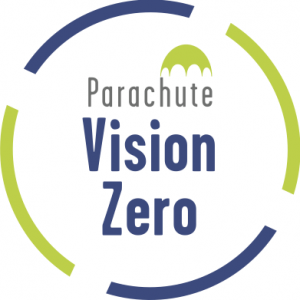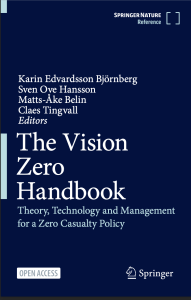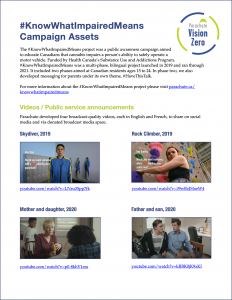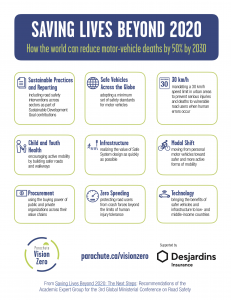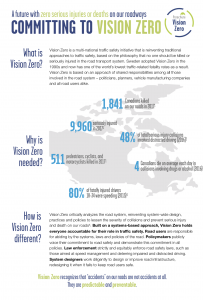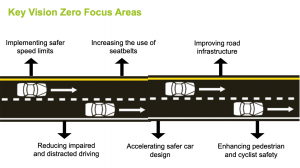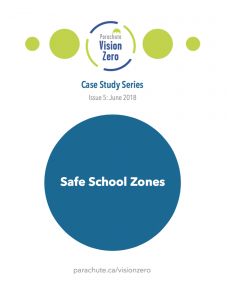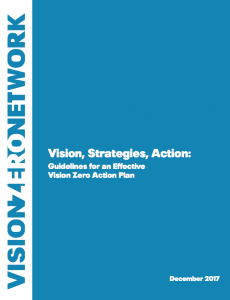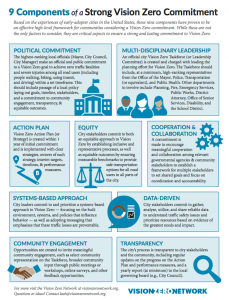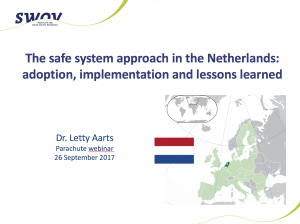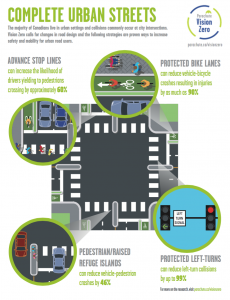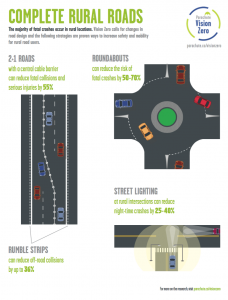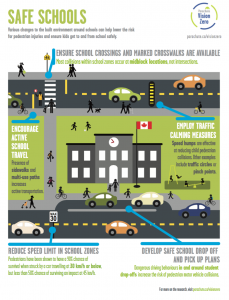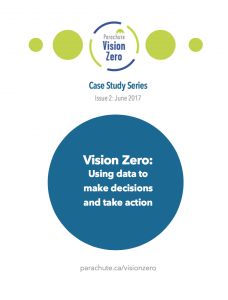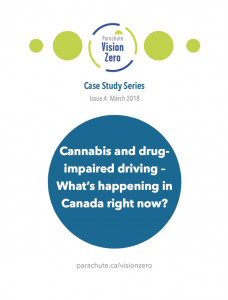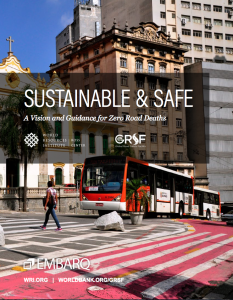All resources
-
Lessons from sharing the waterfront with e-scooters and e-bikes
-
Insights from the 3rd Global Youth Assembly and 4th Global Ministerial Conference on Road Safety in Morocco
-
Q&A with Paul Mackey on Street Redesign and Traffic Calming
-
Q&A with Dr. Linda Rothman on Automated Speed Enforcement (ASE) in Toronto
-
Reflections on the 4th Global Ministerial Conference on Road Safety
-
Vision Zero and the Safe System Approach: A Primer for Canada
Developed by the Transportation Association of Canada (TAC), the objectives of this primer are to establish clear definitions and principles for Vision Zero and the Safe System Approach, to promote greater understanding of these concepts, and to support the development, identification and sharing of Canadian best practices.
-
Ontario Traffic Council Vision Zero Guide
The Guide offers in-depth background information on the fundamentals of Vision Zero, the Safe System Approach, and Traffic Safety Culture, and leads municipalities through the steps required to develop, integrate, and implement their own Vision Zero programs.
-
Bigger, heavier, higher … large SUVs and pickups pose serious safety threats to vulnerable road users
-
Supersized vehicles, supersized safety risk (2024)
Large SUVs and pick-up trucks pose a safety threat to all road users. The collisions where a light truck is involved is both more likely to occur, and to cause fatal or serious injury to the involved vulnerable road user. Join panelists from Transport Canada, the Insurance Institute for Highway Safety (IIHS), Équiterre, Piétons Québec and the Coalition to Reduce Auto Size Hazards (CRASH) to learn more about the evidence and discuss how to mobilize and promote use of safer vehicles within Vision Zero.
PANEL:
Samuel Monfort is a Senior Statistician at the Insurance Institute for Highway Safety (IIHS) with a PhD in Human Factors Psychology. His research interests include vulnerable road users, crash compatibility, and the use and misuse of automation.
Dominique Charlebois works at Transport Canada as a Senior Project Manager, Engineering.
Albert Koehl is an Environment Lawyer and Coordinator of CRASH, a Toronto cycling and pedestrian advocate and author of editorials and other publications.
Anne-Catherine Pilon, Sustainable Mobility Analyst at Équiterre advocates for cities and vehicles that are at a human scale and for competitive alternatives to solo cars, through public transit funding.
Francis Garnier is a Public Affairs Analyst at Piétons Québec advocating for pedestrian road safety and transit funding in Québec based in Montréal.
-
Attitudes and perceptions of traffic safety enforcement among police officers in Ontario
-
The crucial role of traffic enforcement in a safe systems approach to road safety
-
Road to Wellness: A case study on equitable solutions for improving air quality through the lens of road safety and transportation (2023)

This case study explores the multifaceted relationship between air quality, road safety, and transportation, with a focus on promoting equitable solutions for enhancing public health and safety. It includes insights from professionals working in the field of road safety and public health in Canada, emphasizing active transportation as a means to combat climate change, reduce emissions, and improve air quality.
569.31 KB PDF/UA
-
Global road safety actions 2023: What you need to know (2023)
Presented by Parachute and CARSP, this webinar built upon the previous webinar and provide an update on the Global Plan for the Decade of Action for Road Safety 2021-2030, along with tools coming out of the eighth global meeting of NGOs advocating for road safety and road victims that took place March 6 to 10, 2023 in El Salvador.
We also shared turnkey social media messages and printable creative tools for all road safety partners to use for the upcoming UN Global Road Safety Week, running May 15 to 21, 2023, which calls on policy makers to #RethinkMobility to make walking, cycling and public transport safe and convenient so that people can make the shift to active, sustainable mobility.
PRESENTERS
Valerie Smith Director, Programs Parachute
Raheem Dilgir President Canadian Association of Road Safety Professionals -
Safe mobility in urban areas – Using data to drive road system decisions
-
Safe mobility in urban areas – Health and wellbeing
-
Safe mobility in urban areas – Environment
-
Change for Good Roads, Episode 1 – Sustainable Cities
Economically, socially, and environmentally sustainable cities are key components of healthy, active and safe urban roads.
Safe, healthy, and sustainable urban roads are only possible if we treat the underlying issues as a complex problem, one that involves not only urban planning, but also public health, engineering and other sectors, and retains a focus on inclusion, equity, sustainability, community and more. There are a range of evidence-based frameworks and interventions that guide global efforts toward safer, healthier, and more sustainable roads. The Decade of Action for Road Safety 2021-2030 promotes the Safe System Approach and Vision Zero and sets targets and goals to guide us to achieve the UN’s Sustainable Development Goals. Through cross-sectoral collaboration, organizations and individuals would be able to make our cities both safer for all road users and healthier for all citizens.
Sustainable cities are ones that not only address transportation and the environmental impact, but also the social and economic aspects to sustainability.
Change is hard. Involve communities early in discussions about changes that will make their neighbourhoods and cities more sustainable to explore the rationale for changes, learn about their ideas, concerns and questions about sustainability.
Road safety is part of sustainable cities for two reasons. The first is that by improving the safety of roads for all road users, it will result in more people walking, biking and taking public transport. The second is by reducing transportation by motorized vehicles, greenhouse gas emissions will be reduced.
Former City Councillor for the City of Toronto Mike Layton joins host Pamela Fuselli for an in-depth discussion. -
Good roads for all: Moving the needle on road safety (2023)
Building on findings from our Change for Good Roads initiative, this webinar explores our next steps to creating safer roads and healthier communities on the one-year anniversary of that report’s release. Moderated by Parachute’s President and CEO Pamela Fuselli, influential Canadian experts from the sectors of sustainable cities, equity, health and wellbeing and road safety will discuss how to move the needle on support for road safety through multi-sectoral collaboration in Canada.
Panelists
Dr. John C. Spence
University of Alberta
Professor
Faculty of Kinesiology, Sport, and RecreationDr. Meghan Winters
Simon Fraser University
Professor
Faculty of Health SciencesArcy Canumay
BYCS Bicycle Mayor of Waterloo -
The role of equity in road safety and mobility interventions
-
Safe mobility in urban areas – Equity
-
Equity in Vision Zero and road safety (2022)
Six Es of traffic safety are commonly used in Vision Zero planning: Engineering, Enforcement, Evaluation, Education, Engagement and Equity. The newest E, Equity, addresses how different barriers and power imbalances can increase road hazards: for instance, lower-income neighbourhoods have poorer built environments and lack of access to transit.
Join moderator Valerie Smith, Director, Programs at Parachute, in conversation with panelists from York University, The Centre for Active Transportation, and WATT Consulting Group` to learn more about applying an equity lens to Vision Zero and road safety planning.
Panelists
Jennie Geleff
Project Manager,
The Centre for Active TransportationEmily McCullogh, Postdoctoral Fellow, School of Kinesiology and Health Science, York University
Shabnem Afzal
Road Safety and Regional Lead
WATT Consulting Group
(previously Vision Zero leader, City of Surrey) -
The Vision Zero Handbook
-
Vision Zero: The Next Generation (2022)
The next generation has spoken, and they are in favor of Vision Zero. Based on a survey done by Desjardins in 2022, 61% of survey respondents between the age of 16-34 support the adoption of a Vision Zero strategy in their region and 56% support increasing government funding for Vision Zero. Road crashes are the third-leading cause of death among young people ages 15 to 24 in Canada. Join modertator Umayangga Yogalingam as she discusses Vision Zero: The Next Generation with Priynka Patil from Parachute, Sana’ Khasawneh, Junior Project Manager at YOURS, and Arianne Khorasani, Max Novak and Emily Shibata, members from our Canadian Youth Road Safety Council. Together, we will discuss the value of engaging youth in Vision Zero action and hear the voices of youth on their experience with road safety in Canada.
-
The role of technology and data in road safety and Vision Zero interventions
-
The role of technology and data in Vision Zero interventions (2022)
Join moderator Valerie Smith, Director, Programs at Parachute, in conversation with panelists from Liveable Cities, the City of Brantford, Ontario, and the City of Bellevue, Washington, as we discuss the role of technology and data in Vision Zero and road safety strategies. This webinar will be of interest to municipal city planners, road safety professionals and road safety researchers.
In this webinar, you’ll hear from David Ferguson, Manager of Traffic Services at the City of Brantford, who will speak to his experience of integrating technology into Vision Zero road safety work. Ferguson supports the use of technology to assist practitioners in improving road safety for all road users. His previous role was Superintendent of Traffic Engineering with the City of Hamilton.
Ken Cartmill, Executive Vice President of Product Development from Livable Cities will then present on their technology solution that collects data on road activities, vehicle speed, traffic analytics, air quality, ambient noise and more. He will speak to how this data can be used for evidence-based decision-making to deploy targeted enforcement, traffic calming measures or other urban and mobility planning applications.
Franz Loewenherz, Mobility Planning and Solutions Manager, City of Bellevue, Washington, will speak to his experience in integrating technology and data into Vision Zero and road safety strategies. He will share his work in the City of Bellevue, as well as speak more generally about the important role of technology and data in Vision Zero and road safety interventions.
-
Factors that impact driving behaviour in young drivers and promising practices for young driver engagement (2022)
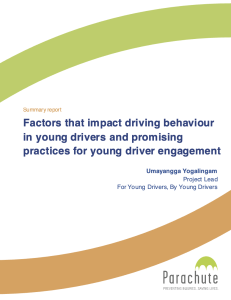
This report summarizes findings from a literature review and environmental scan on: factors that impact driving behaviour in young people; youth engagement and partnership strategies in health promotion and injury prevention programming; and tools and platforms used to engage young people in health promotion and injury prevention programming.
145.69 KB Word
-
Cycling in Canada: Pedalling toward sustainable climate action and Vision Zero (2022)
Parachute and moderator Dr. Linda Rothman, Assistant Professor, School of Occupational and Public Health, Ryerson University, in conversation with panellists from Velo Canada Bikes and Ecology Action Centre.
In this webinar, you’ll hear from Brian Pincott, Executive Director, Velo Canada Bikes, about the new National Active Transportation Strategy and the need for safe and accessible cycling as a transportation option. Pincott will also discuss cycling in the context of new Global Plan for the Decade of Action for Road Safety 2021-2030, and Vision Zero.
Anika Riopel, Sustainable Transportation Co-ordinator, Ecology Action Centre, will talk about cycling and the role it plays in creating sustainable cities and addressing climate change. Riopel will also share information about their projects to make cycling and sustainable transportation decisions easy. The webinar will include a facilitated Q&A session.
PANEL
Brian Pincott
Executive Director
Velo Canada BikesAnika Riopel
Sustainable Transportation Co-ordinator
Ecology Action CentreSponsored by Desjardins
-
Vision Zero Canadian Landscape 3.0 (2022)
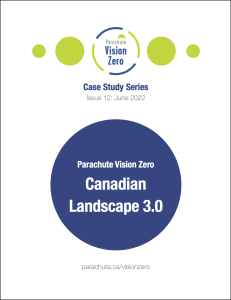
In 2019, Parachute published the Canadian Landscape 2.0, which profiled 24 jurisdictions. This included reviewing the current status of all jurisdictions in the process of considering, adopting or implementing Vision Zero; presenting the key features of their programs, using a consistent framework of the five (now six as of 2022) Es of traffic safety (further described in Section 1); and discussing the successes and challenges faced by these programs with key stakeholders, as well as any advice they have for jurisdictions contemplating formal adoption.
This issue of the Vision Zero Canadian Landscape (3.0) revisits these jurisdictions and profiles new areas that have adopted or are adopting Vision Zero. This focus is responsive to earlier feedback from our Parachute Vision Zero Network stakeholders, who had requested a better understanding of how to approach Vision Zero, and the facilitators and barriers to embracing a systems approach to increase road safety and end road fatalities and serious injuries.
969.22 KB PDF/UA
-
Encouraging active transportation for children (2022)
Active transportation – such as waking, biking and wheeling – are sustainable forms of mobility that not only gets us to where we want to go, but also improve our physical and mental wellbeing.
Join moderator Pamela Fuselli, President & CEO of Parachute, as we discuss how to create and sustain active spaces for children to get to and from school and move though their communities safely.
-
Taking Action: The Global Plan for the New Decade of Action for Road Safety 2021-2030 (2022)
This free webinar provides an overview of the Global Plan for the Decade of Action for Road Safety, 2021-2030, shares the regional call to action for Canada and discusses next steps. We also share information about the upcoming #CommitToAct 2022 campaign, running from May 16 to 20, and discuss the role NGOs, local government and other stakeholders can play to encourage their government leaders to make specific, meaningful commitments to reduce road traffic deaths and injuries.
-
The Global Plan for the New Decade of Action for Road Safety 2021-2030: What You Need to Know (2022)
The Decade of Action for Road Safety 2021-2030 has been proclaimed by a UN General Assembly Resolution with a target to reduce road traffic deaths and injuries by 50 per cent by 2030, recognizing the gravity of this global issue.
The Decade of Action is underpinned by the Global Plan, launched Oct. 28, 2021, which aims to inspire and guide national and local government, as well other stakeholders who can influence road safety. Those include civil society, academia, the private sector, donors, community and youth leaders, and other stakeholders as they develop supporting national and local action plans and targets. Through advocating for the Safe Systems Approach and providing recommendations based on best practices and research, the plan is an important resource both within Canada and abroad.
The webinar will provide an overview of the Global Plan, including three parts of road safety action: what to do, how to do it and who does it. Panelists will also discuss how road safety needs to be integrated into other policy agendas such as climate action and equity, to increase its reach and influence. The webinar will also refer to Canada’s Road Safety Strategy 2025.
MODERATOR
Brenda Suggett, Executive Director, CARSPPANELISTS
Raheem Dilgir, President, CARSP
Valerie Smith, Director, Programs, Parachute -
Change for Good Roads – An intersectoral approach to urban road safety (2022)
-
Change the language, change perceptions: how we talk about road collisions (2021)
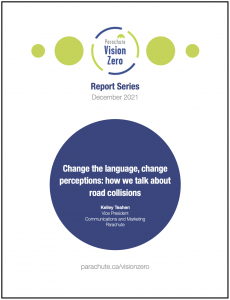
For many years, road safety advocates have argued it’s inaccurate to use the word “accident”to describe road collisions because that implies nothing could be done to prevent them. Thanks to advocacy by Parachute, the Canadian Press now has made this change to its Caps and Spelling style manual. Under the word “accident”it now reads: “avoid in reference to motor vehicles; prefer crash or collision.” A change in Canadian Press style means an enforceable change in language used in news coverage across the country.
Read the report detailing how we achieved this policy change and our plans for future advocacy.
918.98 KB PDF/UA
-
Why it is important to examine Vision Zero initiatives through a gender lens
-
Making a Vision Zero Commitment in Canada presentation template
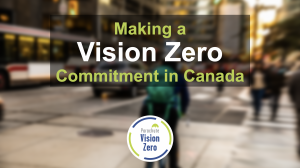
Parachute has developed a customizable Powerpoint presentation for local champions to use with senior policy makers to move Vision Zero forward, whether they are in the pre-adoption or adoption stage.
The presentation includes:
- Background of Vision Zero and its importance
- Tools for implementation
- The stages of becoming a successful Vision Zero jurisdiction
4.49 MB PowerPoint
-
#Know
What Impaired Means Campaign Assets -
Taking the high road: campaigning for safe driving (2021)
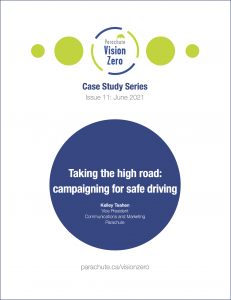
Parachute has developed and led awareness campaigns to engage young Canadian residents, challenge their perceptions and raise awareness of the dangers of driving while high and speeding – all within the framework of our larger, systems- change commitment to road safety through Vision Zero.
10.92 MB PDF/UA
-
Multi-modal transportation: Making the link between climate action and road safety (2021)
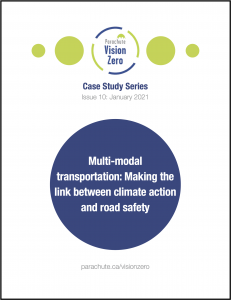
This case study will focus on multi-modal transportation and its unique link between climate action and road safety, primarily considering urban settings. The purpose of this case study will be to understand how MMT can be a vital tool for meeting both GHG emissions reduction and Vision Zero goals and make the case for jurisdictions to consider this intersection in their road safety planning.
1.91 MB PDF/UA
-
Perceptions of Vision Zero in Canada (2020)
Join Parachute’s President and CEO, Pamela Fuselli, in conversation with a panel of journalists from across Canada to discuss perceptions of road safety in our communities and Vision Zero measures being implemented by Canadian jurisdictions. Are they working? Do people think they’re working? Panel: Jason Magder, transportation reporter, Montreal Gazette; Elizabeth Payne, reporter, Ottawa Citizen; Ben Spurr, transportation reporter, Toronto Star; Jason Tchir, freelance journalist and columnist, Vancouver, B.C.
-
Changing perceptions on Vision Zero in Canada: A media audit (2020)

This Case Study, developed with generous support from Desjardins, reviews media coverage in various Canadian jurisdictions related to Vision Zero. This point-in-time audit compares media coverage over two time periods, reflecting on changes, or lack thereof, over time in language used to report on road safety, apportion of blame for injury and incidents on the road, as well as the frequency and tone of Vision Zero discussions.
1.67 MB PDF/UA
-
The shocking pile of shoes
-
Why are cars made to go that fast? Speeding and road safety during COVID-19 (2020)
Join Parachute’s President and CEO, Pamela Fuselli, in conversation with a panel of experts to discuss the road safety and public health concerns due to the recent spike in speeding and stunt driving on now-emptier roads across Canada, the reasons why drivers speed, and what we can do about it. Panel: Ken Lindhardsen, Vice-President of Accident Benefits and Benefits and Bodily Injury for Desjardins; David Mele, Product Planning Manager at Volvo Cars Canada; Sgt. Kerry Schmidt, Ontario Provincial Police Highway Safety Division; Dr. Christine Wickens, Independent Scientist with the Institute for Mental Health Policy Research at the Centre for Addiction and Mental Health
-
Imagining Car Use and Road Safety Post COVID-19 (2020)
Parachute’s President and CEO, Pamela Fuselli, in conversation with Rachel MacCleery, Robin Mazumder, and Craig Milligan to discuss international examples such as Milan’s proposal to permanently reallocate street space from cars to cycling and walking following the COVID-19 crisis, what this could look like in a Canadian context and how we can all advocate for changes.
-
Saving lives beyond 2020: How the world can reduce motor-vehicle deaths by 50% by 2030
-
Embracing a new decade of improved road safety goals
-
Thinking Differently – A look at Canadian cities’ immediate response to COVID-19 to make space for social distancing (2020)
Parachute’s President and CEO, Pamela Fuselli, discusses with a panel of experts the current and next phase of Canadian road use post-COVID-19 as restrictions are lifted. Panelists include: Bartek Komorowski, Planning Advisor, Road Safety and Human Behaviour, Ville de Montréal; Linda Rothman, Assistant Professor, School of Occupational and Public Health, Ryerson University, Toronto; and Brent Toderian, Urban design and planning consultant, TODERIAN UrbanWORKS, Vancouver
-
COVID-19, Safer Roads and Urban Planning (2020)
Jennifer Keesmaat, former Toronto chief city planner, and Oliver Moore, urban affairs reporter at the Globe and Mail, discuss safe streets and urban planning in the context of COVID-19 and the lessons that we can learn from it. Facilitated by Pamela Fusell, President and CEO, Parachute.
-
Becoming a Vision Zero community
-
Indicators of a Vision Zero community
-
Making a Vision Zero commitment in Canada
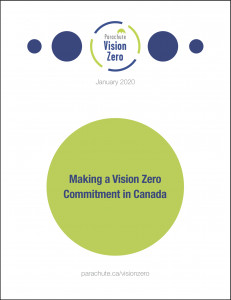
This paper, developed with generous support from Desjardins, provides national thought leadership on a practical implementation of Vision Zero in Canada. It briefly summarizes the roots of Vision Zero and the current status of Vision Zero across Canada. It also provides a high-level review of Vision Zero and road safety frameworks from Canada and internationally. By using an injury-prevention approach based in public health theory, the paper provides information not only on Vision-Zero-specific implementation but will also address the contextual factors that impact these efforts, such as community readiness. Tools created by Parachute and links to other tools supplement the paper by providing useful resources that address the needs of stakeholders at all stages of their Vision Zero commitment.
23.02 MB PDF/UA
-
Vision Zero: The Next Generation
An important step toward achieving zero fatalities and serious injuries on our roads is to create a new generation of drivers committed to improving their skills and reducing their chances of causing a serious crash.
-
Vision Zero Canadian Landscape 2.0: Successes and Opportunities (2019)
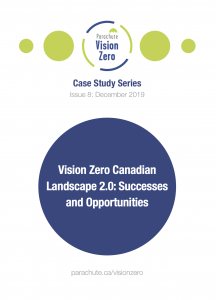
This case study reviews the current status of Canadian jurisdictions in the process of implementing or considering Vision Zero, presenting the key features of their programs. The study profiles 24 jurisdictions, including 14 interviews with local road safety advocates. These interviews discuss the successes and challenges faced by these programs with key stakeholders and provide advice for jurisdictions contemplating formal adoption of Vision Zero.
1.24 MB PDF
-
Committing to Vision Zero – A Primer
-
Vision Zero Canadian Landscape: Learning from Key Stakeholder Experiences (2019)
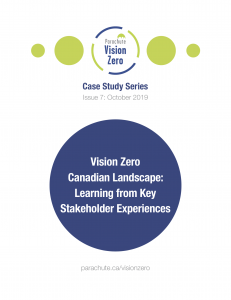
This case study shares interview responses from nine Canadian cities, regions and provinces implementing Vision Zero. These interviews discuss the successes and challenges faced by these programs with key stakeholders, and provide advice for jurisdictions that are contemplating formal adoption of Vision Zero.
1.06 MB PDF/UA
-
Vision Zero in Canada: The Canadian Association of Road Safety Professionals (2019)
-
Safe School Zones (2018)
-
The Canadian landscape (2017)
-
Complete Streets Evaluation tool
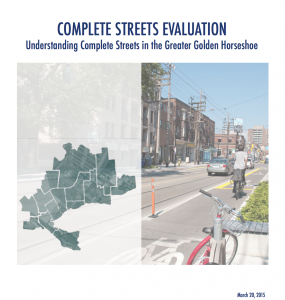
The Complete Streets Evaluation Tool is comprised of 21 performance indicators that are aimed at helping municipalities assess the effectiveness of their Complete Streets projects. The indicators are organized within four broad goals: (1) active transportation, (2) level of safety, (3) level of service, (4) surrounding environment.
-
Vision, Strategies, Action: Guidelines for an Effective Vision Zero Action Plan
-
Core Elements for Vision Zero Communities
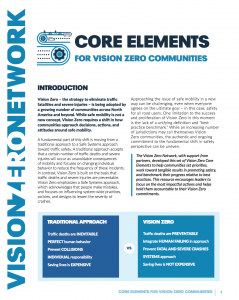
This resource was designed to help communities set out their Vision Zero priorities, create meaningful results related to road safety, and compare their progress to best practices. The resource encourages leaders to focus on the most effective actions and will help to hold them accountable to the commitment made to Vision Zero.
-
9 Components of a Strong Vision Zero Commitment
-
Sgt. Kerry Schmidt describes how the OPP uses data (2017)
Sgt. Kerry Schmidt from the Ontario Provincial Police discusses collision statistics in Ontario and how enforcement uses data to allocate resources (two minutes).
-
The Parachute Vision Zero Network 2nd Annual Summit (2017)
This video promotes Parachute Vision Zero Network’s 2nd Annual Summit (October 16-17, 2017), a two day conference that brings together grassroots organizations, enforcement, public health professionals and researchers to discuss the implementation of Vision Zero (two minutes).
-
Interview with Heather Woods Fry from Traffic Injury Research Foundation (TIRF) (2018)
Parachute’s Matt Aymar interviews Heather Woods Fry with the Traffic Injury Research Foundation about their newly launched Drug-Impaired Driving Learning Centre, sponsored by State Farm Insurance (10 minutes).
-
A panel discussion on Safe School Zones: Vision Zero neighbourhood by neighbourhood (2018)
This moderated discussion features four panelists filmed at the Children’s Safety Village in Oakville. The discussion explores: What does a Safe School Zone look like under the Vision Zero framework? Can it work in your community? What are some of the issues and solutions around collision prevention in school zones? (50 minutes).
-
Distracted Driving: Changing the Culture (2018)
A Vision Zero panel discussion held at Espace Desjardins, Montreal. A panel of experts discuss the dangers of distracted driving and what is being done to counter it (60 minutes).
-
Vision Zero in Canada (2019)
Parachute Interim CEO, Pamela Fuselli, speaks about Vision Zero in Canada as keynote speaker at the Canadian Association of Road Safety Professionals conference in Calgary (30 minutes).
-
The Safe Systems Approach in the Netherlands: Adoption, implementation and lessons learned
-
Implementation experiences in three Canadian urban communities (2019)
-
Complete urban streets
-
Complete rural roads
-
Collision avoidance technologies
-
Teen beliefs about cannabis and driving
-
Safe schools
-
Using data to make decisions and take action (2017)
-
Do collision avoidance systems make our roads safer? (2017)
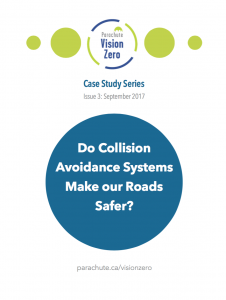
This Case Study goes into detail about the implementation of technology into cars and the effect that has on collision rates. It analyzes four collision avoidance systems: lane departure warnings, forward collision warning and braking, advanced forward lighting and blind spot detection.
The analysis discusses the safety benefits and risks of each system, the limitations of current research and the future of technology in motor vehicles.
1.96 MB PDF/UA
-
Cannabis and drug-impaired driving – what’s happening in Canada right now? (2018)
-
Safer Journeys New Zealand
-
The Netherland’s SWOV Institute for Road Safety Research
-
The U.S. Vision Zero Network
-
Sweden’s Vision Zero initiative
-
Australia’s Safe System approach
-
Vision Zero: A toolkit for road safety in the modern era (2017)
This article considers the applicability of Vision Zero to real-world traffic-infrastructure is looked at to show the toolkits available for policymakers to increase road safety in a local context.
Applications of these principles to real-world traffic infrastructure are explored in order to show policymakers the toolkits available to increase road safety while taking into consideration local contexts. -
Sustainable and Safe: A Vision and Guidance for Zero Road Deaths
-
Canada’s Road Safety Strategy 2025
-
Vision Zero International Handbook
-
The Canadian Vision Zero Landscape: A Parachute White Paper
Parachute is preparing a white paper, to be shared through the Parachute Vision Zero Network and presented at conferences, that will undertake an in-depth analysis of Vision Zero in Canada, examining where different regions of the country are on the continuum of concept to implementation and evaluation.
-
Engaging Youth as Community Actors: National Teen Driver Safety Week
Youth hold an important place within Vision Zero. For one, children and youth are among the most vulnerable road users. In Canada, young drivers die in crashes at a higher rate than any other age group[1]. Canadians aged 5 to 14 are at greater risk of being killed as a pedestrian than any other age group[2]. On the road to zero, many jurisdictions are making the safety of children and youth their first priority, as evidenced by Vision Zero for Youth.
-
Parachute launches “This was not an accident” Vision Zero awareness campaign
Donated billboards in B.C., Alberta, Ontario and Montreal drive understanding that road collisions can be prevented.
-
Canadian Child Safety Report Card results
Provinces with strong evidence-based injury prevention policies have fewer child and youth hospitalizations and deaths from road-traffic-related causes.
-
Is the ability to operate a cell phone via Bluetooth influenced by the driver’s vehicle?
Martin Lavallière is a professor in the Department of Health Sciences (Kinesiology Program) at the University of Quebec in Chicoutimi. His research focuses on road safety, human factors and ergonomics and mobility and autonomy.
-
2018 Vision Zero Advocate Conference in Toronto
The 2018 Vision Zero Advocate Conference in Toronto February 28 – March 2 was a highly informative event, where Canadian and international experts – from government and major corporations, to grassroots advocates – came together to share their experiences and discuss “What’s next for Vision Zero?”
-
Cannabis research suggests feds’ pot laws a guessing game – by Ed Prutschi
For a government that promised to legislate using evidence-based science, the rapid approach of legalized marijuana in Canada is starting to look like a case study in blind faith.
-
Using Drones to Make Roads Safer
Unmanned Aerial Vehicles (UAVs) or “drones” are being used by traffic engineers and road safety professionals to enhance data collection and road safety efforts. On September 8, 2017, we sat down with Mark Hearson, a Rhodes Scholar in civil engineering and Transport Infrastructure Specialist from Fireseeds North Infrastructure in Winnipeg, to discuss how drones are changing traditional approaches to road safety.
-
Technology, urbanism, and the car: What is the future of road safety?
How is technology changing? To who’s benefit? And what does this mean for Vision Zero?Well to begin with, the world is becoming more urban. By 2050 it’s expected that nearly 90% (87.6 to be exact) of Canada’s population will live in urban areas. This has city planners, architects, engineers and policy makers re-designing our cities to be more dense, mobile, green and economically vibrant.
-
An Interview with Operation Lifesaver
Operation Lifesaver (OL) is a not-for-profit that works to educate Canadians about rail safety.
-
Vision Zero: North Bay Road Safety Strategy
Pat Cliche and Staff Sgt. Rick Dubeau are Co-Chairs of the North Bay Road Safety Committee. Pat is also known to Parachute staff in her role as Northern Injury Prevention Coordinator (OIPRC). We interviewed them to find out more about how North Bay is incorporating Vision Zero into their community’s road safety approach.
-
An Interview with ATS & The Vision Zero Advocate Institute
The Vision Zero Advocate Institute is the natural evolution of 50 years of traffic safety solutions. Supported by ATS Traffic, the Institute is a network of coaches, experts and Vision Zero innovators.
-
Vision Zero Conference Stockholm
Valerie Smith, Director of Solutions at Parachute, had a great opportunity to attend the International Vision Zero Conference in Stockholm, Sweden June 14-15.
-
Vision Zero: What the numbers tell us
Thank you for a very successful launch of the Parachute Vision Zero Network. From partners signing up (by the hundreds!), to community organizations sharing our messages to governments getting engaged, we are thrilled with the response!We are pleased to announce our second Vision Zero Summit! SAVE THE DATE! The Summit will be taking place in Toronto on October 16th and 17th at the Marriott Downtown Eaton Centre Hotel.
-
An Interview with The Jessica Campaign
An interview with Jeannette Holman-Price of The Jessica Campaign. The Jessica Campaign (“TJC”) is a public advocacy for long overdue upgrades to motor vehicle safety standards and legislation across North America. Started in Canada following the preventable and needless death of 21-year-old Jessica Holman-Price, M.B., TJC continues to strive to become a leading force behind Canada’s Vision Zero Goals.
-
Vision Zero Cities 2017 Conference, New York City
The Vision Zero Cities 2017 Conference in New York City provided an inspirational and transformative experience, showcasing the Vision Zero Movement both in U.S. and internationally.
-
Message from our CEO
Our first blog marks the official launch of the Parachute Vision Zero Network. We discuss the development, goals and some of the resources that we will be publishing on a quarterly basis.
